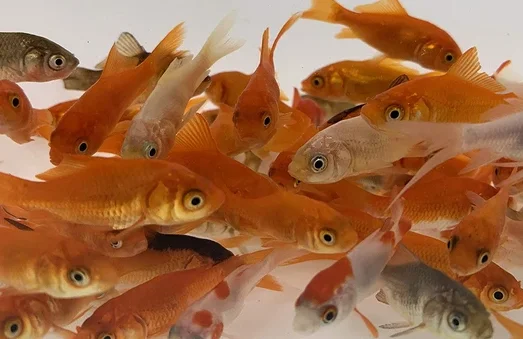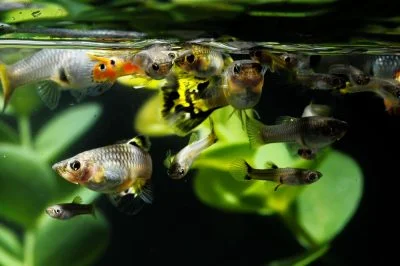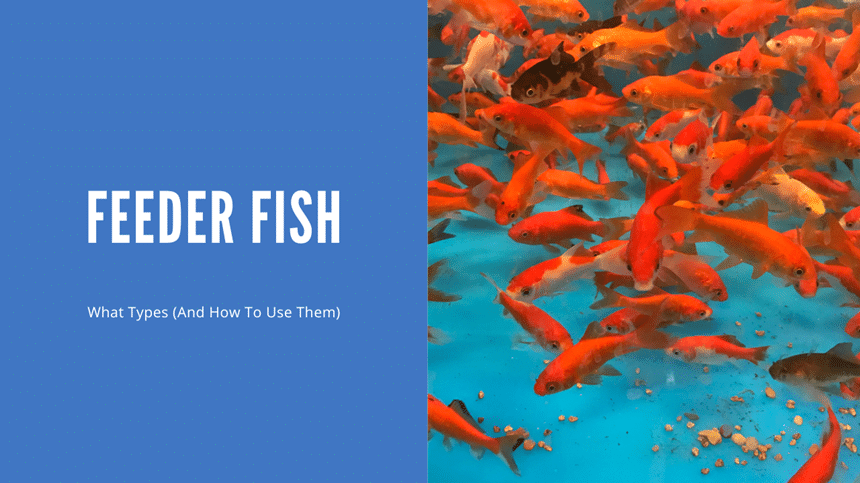Thank you for visiting! By the way… any links on this page that lead to products on Amazon and other stores/partners are affiliate links Aquarium Store Depot earns a commission if you make a purchase.
You might’ve seen a big tank full of cheap goldfish or guppies at your local pet store. These fish aren’t meant to be bought for regular aquarium stocking–though some hobbyists like to rescue them! Instead, these are feeder fish that can be given as a fun treat for bigger fish, amphibians, and invertebrates. As we’ll see, not all feeder fish are the same.
Keep reading to find out everything you need to know before choosing the right live fish for food and which ones you might want to avoid!
Key Takeaways
- Predatory fish can be fed an assortment of feeder fish.
- Feeder fish can vary in size and quality, so it’s important to buy the right ones for your fish.
- The best feeder fish are raised in their own aquarium with a high-quality diet.
- A nutritious feeder fish can be fed once or twice a week depending on the species and the size of the predator.
What Are Feeder Fish?

Feeder fish are any type of fish that has been bred to serve as food for other aquatic life. This can include an array of species, both freshwater and saltwater.
Feeder fish are often seen in local fish and pet store locations. They are usually kept by the dozens or hundreds in a big, empty tank. These are usually feeder goldfish, guppies, platies, or other tropical livebearers, and are priced at less than $1.00 each.
Unfortunately, these fish are not kept in the best conditions. They are seen as highly disposable and not worth the cost of upkeep. As a result, infection, disease, and mutations run rampant. This makes it very easy for these same ailments to be added to the home aquarium during feeding times. For this reason, many hobbyists who heavily rely on feeder fish breed their own stock.
Feeder fish can also be well-fed guppies and platies from a heavily planted display aquarium. Many hobbyists understand that the love and care they give for feeder fish translates into the overall health of their predatory fish. For this reason, many hobbyists with carnivorous fish raise their own feeder fish in regular aquarium conditions. Some even plump their feeder stock up with high-quality foods to ensure that their bigger fish get a nutritious treat.
Benefits To Live Food
For years, there has been discussion surrounding the ethics of feeding live fish to aquarium fish. With all the great food options available, some hobbyists don’t see it necessary to offer live food. While we can’t tell you what’s right or wrong, we can give you some of the benefits of feeding live fish.
Enrichment
The biggest benefit of offering live fish as food is providing enrichment for other fish. Fish are limited to their tank environment, and they likely get bored every now and then. They might even get tired of having the same thing for dinner every night in a row.
Offering feeder fish provides a new enrichment element in the tank by making the other fish use their predatory instincts. This can stimulate your fish’s instincts and activity levels.
Natural Habitat
A predatory species likely eats other fish in the wild. This isn’t always true as some fish are strictly insectivores, but if your fish can fit another species in its mouth, then it’s likely that they eat fish in their natural habitat.
Nutrients
While aquarium foods are usually packed with nutrients, one food can’t cover every single mineral and nutrient. Because of this, most hobbyists have a rotating diet with many different food options. One of these options might be feeder fish.
If the hobbyist chooses to raise their own feeder fish, then there is even greater control over nutrient intake for both the prey and the predator.
Sometimes It’s Necessary
One reason live food might be necessary is that your fish might be wild caught. While many fish have been successfully bred in the aquarium hobby, some are still collected. Unless they are shown how to eat flake or pellet food, they might need to be given a strictly live diet for a while. This is also true if the fish is picky.
Types
The most common types of feeder fish to see for sale are goldfish and guppies. Depending on whether you have access to a bait shop or a more specialized store, you might have access to better, and sometimes cheaper, alternatives.
Here are some of the different options you might come across and how each can be fed!
Bluegill
Bluegills are very common North American freshwater fish found in ponds and lakes. They are scientifically known as Lepomis macrochirus and are often sold for freshwater fishing.
While some hobbyists catch bluegills to keep as aquarium pets (check with state laws as this could be illegal), others use these fish as food for their other pond fish, like bass. These fish may be found for sale in a commercial fishing store, but are most often caught from local waterways. This can introduce parasites and other diseases into the aquarium.
Another consideration to take into account is that bluegills are large fish that grow up to a foot long. While they are often sold as juveniles under 5 inches, if your fish doesn’t eat, then you might end up with a bluegill tank mate! Bluegills are also relatively aggressive, which could become problematic in the future.
Goldfish

Goldfish, Carassius auratus, are arguably the most common feeder fish available as both freshwater and saltwater predators eat them. They are easy to find and usually marked at an extremely low price. However, there are a lot of problems that can come with goldfish.
As you may know, goldfish are some of the messiest fish in the aquarium hobby. Setting up and maintaining a healthy supply of goldfish can be difficult for the average aquarist. Purchasing live goldfish from the store can also be challenging as disease runs rampant in unclean and unmonitored store tanks.
The same problem arises from keeping goldfish as bluegills, and that’s that goldfish can grow to extreme sizes depending on the breed. While some breeds stay small, under 4 inches, others can grow to be a couple feet. Unless you know how to identify breeds of goldfish (and not trust what they’re listed as at the store) then you might not know what you’re getting yourself into.
There is another underlying problem that hobbyists aren’t even aware of: thiaminase. Thiaminase is a necessary enzyme that helps break down vitamin B1 in several species, including goldfish. Though this enzyme is essential for the fish, ingesting large amounts of it can lead to thiamin deficiency in other organisms.
Guppies

Guppies are another popular choice and the term includes some subcategories. These fish often cost even less than goldfish and are just as available. As these fish stay under about 1.5 inches, they can be fed to a variety of tropical fish.
Commercial feeders suffer from the same poor conditions as goldfish, meaning that disease and infection can easily be transmitted. Many species of guppy also contain thiaminase, which can start to affect the animals being fed after prolonged ingestion.
Other alternatives to guppies might be:
- Mosquito Fish (2.8 inches)
- Minnows (2.5 inches)
Mosquito fish, minnows, and guppies are often sold alongside each other as feeder fish. You may not even be able to tell them apart when they’re kept in the same poor conditions. Luckily, they are very easy to breed in the home aquarium and can be fed with high-nutrition foods.
Unfortunately, both of these fish still increase the chances of thiamin deficiency.
Platies

Platies are less commonly found as feeder fish, but many aquarists use them in their own homes as they reproduce rapidly. These fish also stay between 2-3 inches, which makes them easy to feed to most moderately-sized fish.
If you’re going to feed feeder fish, then platies are probably some of the most reliable, as long as you’re breeding your own. These are easy and hardy fish that can easily be fed and prepared for feeding. As of now, platies are also not known to cause thiamin deficiency in other animals1.
Why Are They Bad?
While there are definitely benefits to giving feeder fish to predatory species, like enrichment and nutritional value, there are a lot of reasons why you might be hesitant to try. Here are some remarks from esteemed aquarist and scientist Dr. Neale Monks (see his full article at WebWebMedia).
Disease and Illness
As already mentioned, most feeder fish from pet stores are diseased. These are cheap fish that are disposable and will not have their tanks properly taken care of. This, in addition to a high turnover rate, makes it a near-guarantee that some ailment or bacteria will unknowingly enter your aquarium during feeding times.
Poor Nutritional Value
Yes, feeder fish provide different nutrients than your fish would normally get from a singular fish food. However, a feeder fish is only as nutritional as the nutrition it eats. Since feeder fish aren’t usually taken care of in a commercial setting, they provide little to no additional nutritional benefit.
Thiaminase
The enzyme thiaminase can also cause more trouble than what it’s worth. This is an enzyme that’s necessary for breaking down vitamin B1 in many species, including goldfish, minnows, and other invertebrates. Overindulgence of a thiaminase source, like feeder fish, can start to cause a thiamin deficiency in the predator. This can quickly lead to health problems that may not be obvious to treat and eventual death.
How To Keep Them Healthy
The key to a happy and healthy fish is giving happy and healthy feeder fish. This means only purchasing from fish stores that keep clean and healthy tanks, and setting up your own breeding tanks if possible.
This setup doesn’t need to be extensive, but it should support whichever species you choose to raise. There are a few things to keep in mind when choosing a feeder:
- Pick a species that can be easily eaten. In terms of size, your fish should be able to swallow the other fish without any problems. Avoid species with sharp fins or body features that could potentially damage your fish’s mouth or esophagus.
- Pick a livebearer species. Livebearer species are practically self-sustainable and will provide food for your fish as long as you give them a space to do so. It is also recommended to keep herbivorous livebearers as they can be given plenty of nutritional value through algae flakes and pellets..
- Price. Of course, you will need to consider the price if planning to feed store-bought fish. Keep in mind that you don’t need to feed your fish fresh food every day of the week. In fact, it’s better to only feed them once or twice a week! Still, you will need to consider the price, frequency, availability, and quality of the feeders.
Can you feed your fish other fish?
Yes! Many species of tropical fish available are predatory fish that rely on consuming other fish and animals for nutrition. In their natural habitat, they would receive nutrients and enrichment from hunting, which can be replicated in the aquarium setting.
What is the best feeder fish?
The best feeder fish is one that has been prepared for feeding. Many pet stores have feeders available, but their tank setups usually suffer from overpopulation and poor water quality. The best feeder will come from a clean setup that receives plenty of nutritional value.
How often should you feed live fish?
Live fish should be given as a treat once or twice a week. Depending on the size of the fish, and the size of the feeders, your fish might only need to hunt every couple of days.
If your feeder fish are from a reputable source, you may be able to keep uneaten food in the tank. Otherwise, they should be removed.
Conclusion
One of the reasons you likely got a predatory fish is to feed it! Feeding time can be exciting, and offering live foods can be a great way to introduce enrichment and additional nutrients into the aquarium. However, there are a few considerations that need to go into picking the right feeder fish, like size and quality. For the best results, raise live fish in a secondary aquarium.
- About the Author
- Latest Posts
I’m thrilled that you found Aquarium Store Depot! Here you’ll find information on fish, aquariums, and all things aquatics related. I’m a hobbyist (being doing this since I was 11) and here to help other hobbyists thrive with their aquariums! I adhere to a high quality Editorial Process and Review products with real life field usage and practical analysis.






Mark,
Thank-you for a nicely comprehensive article. Right now the wife and I are feeding a racoon that has recently discovered our half barrel water garden situated on a small, grade level, patio. He is a piece of work and has been observed in the half barrel with his back against the side wall and his arms on the rim like he was “spa”ing. The water plants ravaged, as he felt around for the fish… Oh, well! (Sweet)Stinker… As you might imagine we are not inclined to feed him “famously”.
At the end of a hot 2023 summer, we lost our last two gold fish who were by a couple years pre-pandemic feeder fish. I believe the issue was heat stress. They were close to a hand span each in length and although they were both Tench, is it?, in skin color when we bought them, they both grew up to be flawless specimens, one orange with long fins and tail, and the other just a beautiful, yellow, monster, comet. For some reason we have not had the same success with restocking since, thus time spent with your “hit” this afternoon.
We’ve kept a container water garden successfully for decades thirteen stories up, none-the-less, now that we’re down to earth, I’m going to check on some of the things you mentioned in your presentation.
Just a word of appreciation, Thanks!
T. & C.
Thanks for your comment T. & C. For Racoons try a night watch system. They light up red lights that scare Racoons away